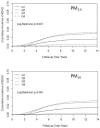Association between Exposure to Particulate Matter Air Pollution during Early Childhood and Risk of Attention-Deficit/Hyperactivity Disorder in Taiwan
- PMID: 36498210
- PMCID: PMC9740780
- DOI: 10.3390/ijerph192316138
Association between Exposure to Particulate Matter Air Pollution during Early Childhood and Risk of Attention-Deficit/Hyperactivity Disorder in Taiwan
Abstract
(1) Background: Recently, a growing number of studies have provided evidence to suggest a strong correlation between air pollution exposure and attention-deficit/hyperactivity disorder (ADHD). In this study, we assessed the relationship between early-life exposure to particulate matter (PM)10, PM2.5, and ADHD; (2) Methods: The National Health Insurance Research Database (NHIRD) contains the medical records, drug information, inspection data, etc., of the people of Taiwan, and, thus, could serve as an important research resource. Air pollution data were based on daily data from the Environmental Protection Administration Executive Yuan, R.O.C. (Taiwan). These included particulate matter (PM2.5 and PM10). The two databases were merged according to the living area of the insured and the location of the air quality monitoring station; (3) Results: The highest levels of air pollutants, including PM2.5 (adjusted hazard ratio (aHR) = 1.79; 95% confidence interval (CI) = 1.58-2.02) and PM10 (aHR = 1.53; 95% CI = 1.37-1.70), had a significantly higher risk of ADHD; (4) Conclusions: As such, measures for air quality control that meet the WHO air quality guidelines should be strictly and uniformly implemented by Taiwanese government authorities.
Keywords: National Health Insurance Research Database (NHIRD); attention-deficit/hyperactivity disorder (ADHD); particulate matter (PM).
Conflict of interest statement
The authors declare no conflict of interest.
Figures
Similar articles
-
Hyperactivity disorder in children related to traffic-based air pollution during pregnancy.Environ Res. 2020 Sep;188:109588. doi: 10.1016/j.envres.2020.109588. Epub 2020 Apr 25. Environ Res. 2020. PMID: 32504847
-
Longitudinal effects of environmental noise and air pollution exposure on autism spectrum disorder and attention-deficit/hyperactivity disorder during adolescence and early adulthood: The TRAILS study.Environ Res. 2023 Jun 15;227:115704. doi: 10.1016/j.envres.2023.115704. Epub 2023 Mar 20. Environ Res. 2023. PMID: 36940817
-
Long-term exposure to air pollution and risk of Sarcopenia in adult residents of Taiwan: a nationwide retrospective cohort study.BMC Public Health. 2023 Nov 6;23(1):2172. doi: 10.1186/s12889-023-17091-8. BMC Public Health. 2023. PMID: 37932727 Free PMC article.
-
Exposure to air pollution in early childhood and the association with Attention-Deficit Hyperactivity Disorder.Environ Res. 2020 Apr;183:108930. doi: 10.1016/j.envres.2019.108930. Epub 2019 Nov 22. Environ Res. 2020. PMID: 31810593 Free PMC article. Review.
-
Association between ambient gaseous and particulate air pollutants and attention deficit hyperactivity disorder (ADHD) in children; a systematic review.Environ Res. 2019 Jun;173:135-156. doi: 10.1016/j.envres.2019.03.030. Epub 2019 Mar 15. Environ Res. 2019. PMID: 30909100
Cited by
-
The protracted neurotoxic consequences in mice of developmental exposures to inhaled iron nanoparticles alone or in combination with SO2.Front Behav Neurosci. 2025 Jul 25;19:1544974. doi: 10.3389/fnbeh.2025.1544974. eCollection 2025. Front Behav Neurosci. 2025. PMID: 40786615 Free PMC article.
-
Association Between Exposure to Particulate Matter Air Pollution with Risk of Obesity Among Children and Adolescents in Northern and Central Taiwan.Children (Basel). 2024 Dec 19;11(12):1545. doi: 10.3390/children11121545. Children (Basel). 2024. PMID: 39767974 Free PMC article.
-
Prenatal and childhood air pollution exposure, cellular immune biomarkers, and brain connectivity in early adolescents.Brain Behav Immun Health. 2024 May 31;38:100799. doi: 10.1016/j.bbih.2024.100799. eCollection 2024 Jul. Brain Behav Immun Health. 2024. PMID: 39021436 Free PMC article.
-
Estimation of Attributable Risk and Direct Medical and Non-Medical Costs of Major Mental Disorders Associated With Air Pollution Exposures Among Children and Adolescents in the Republic of Korea, 2011-2019.J Korean Med Sci. 2024 Aug 5;39(30):e218. doi: 10.3346/jkms.2024.39.e218. J Korean Med Sci. 2024. PMID: 39106887 Free PMC article.
-
Association Between Ambient Air Pollution and Attention-Deficit/Hyperactivity Disorder (ADHD) in Children: A Systematic Review and Meta-Analysis.Cureus. 2024 Oct 15;16(10):e71527. doi: 10.7759/cureus.71527. eCollection 2024 Oct. Cureus. 2024. PMID: 39544605 Free PMC article. Review.
References
-
- Magnus W., Nazir S., Anilkumar A.C., Shaban K. Attention Deficit Hyperactivity Disorder. In StatPearls [Internet] StatPearls Publishing; Treasure Island, FL, USA: 2022. - PubMed
MeSH terms
Substances
Grants and funding
LinkOut - more resources
Full Text Sources
Medical
Research Materials


